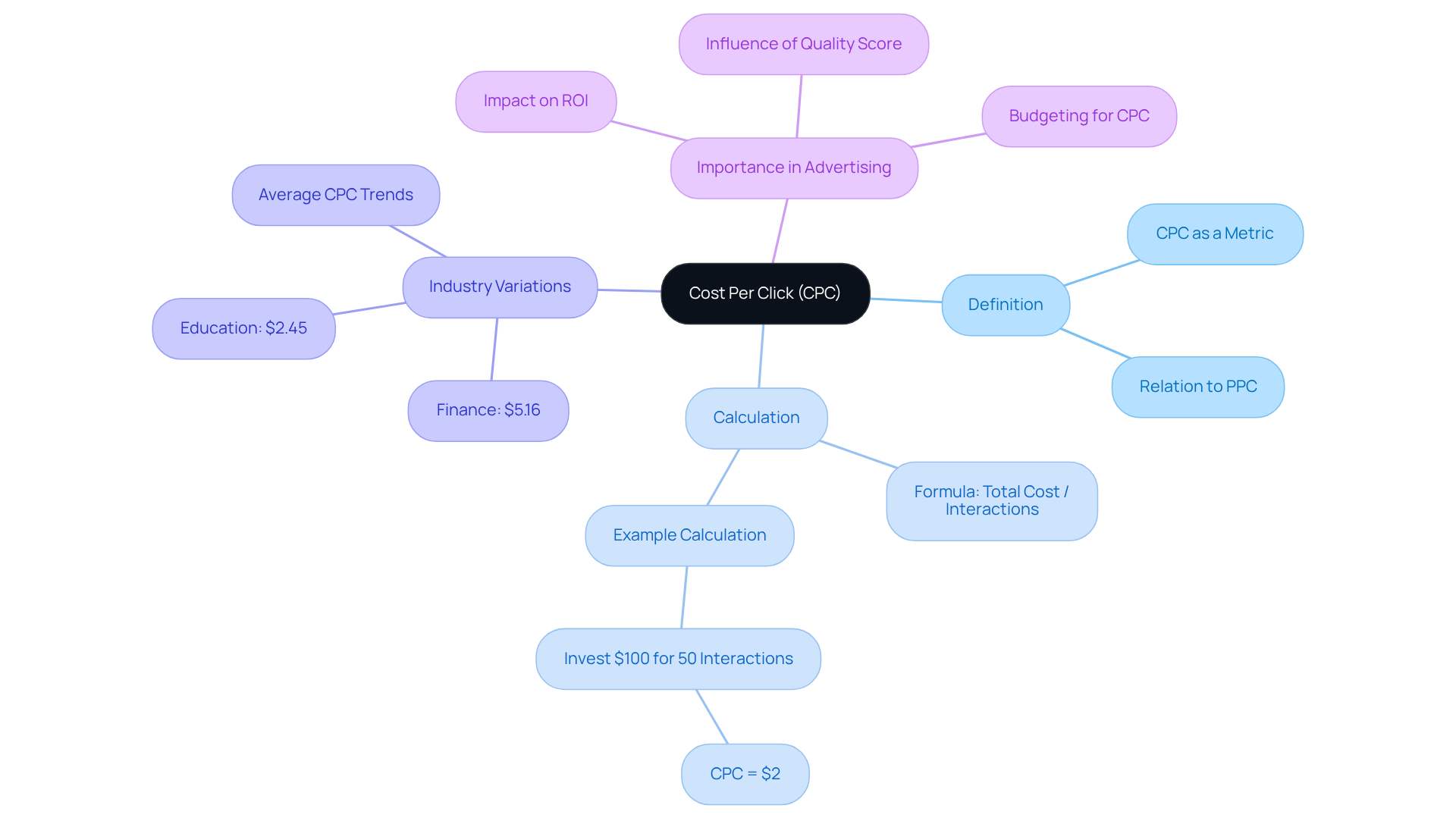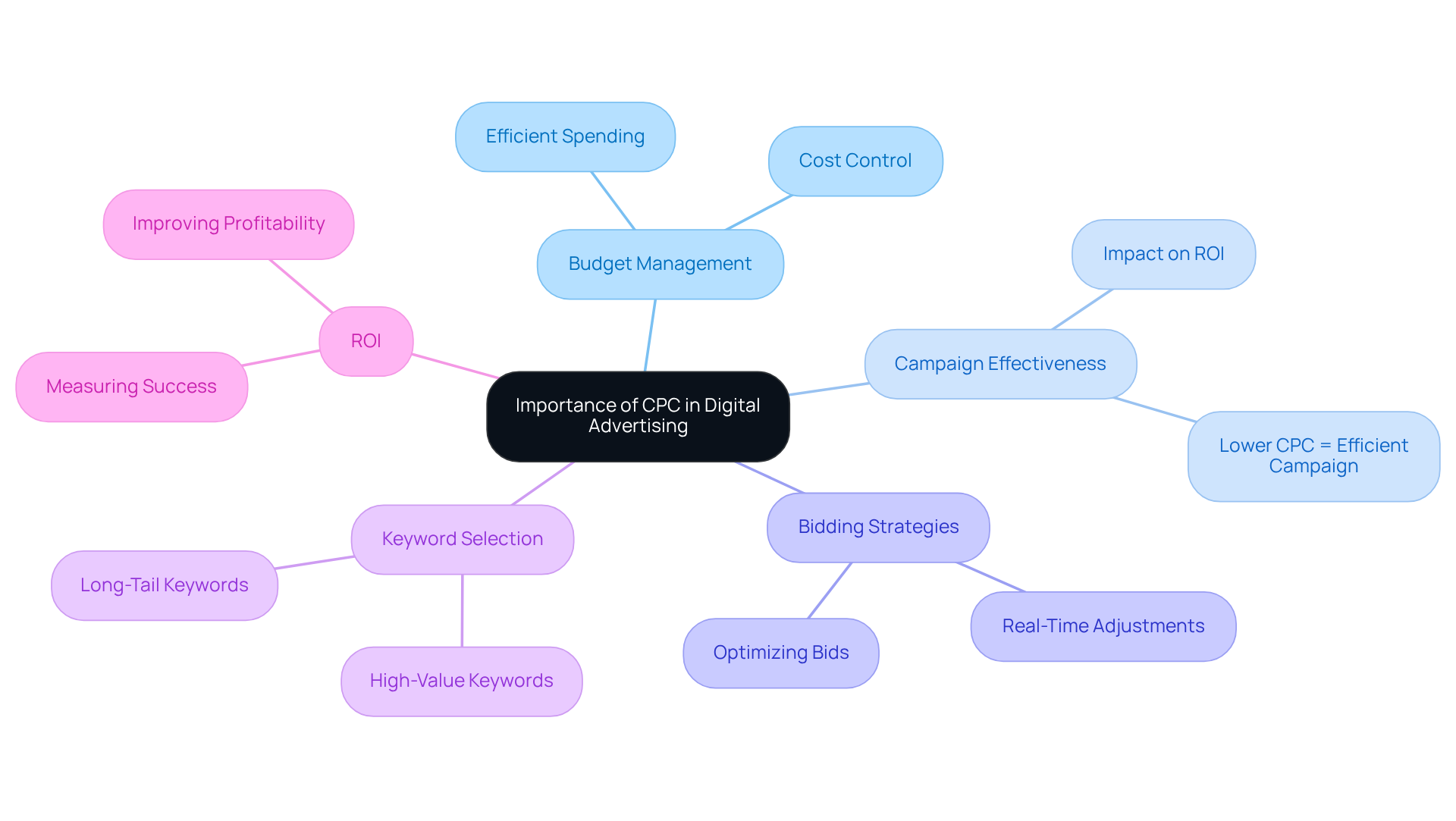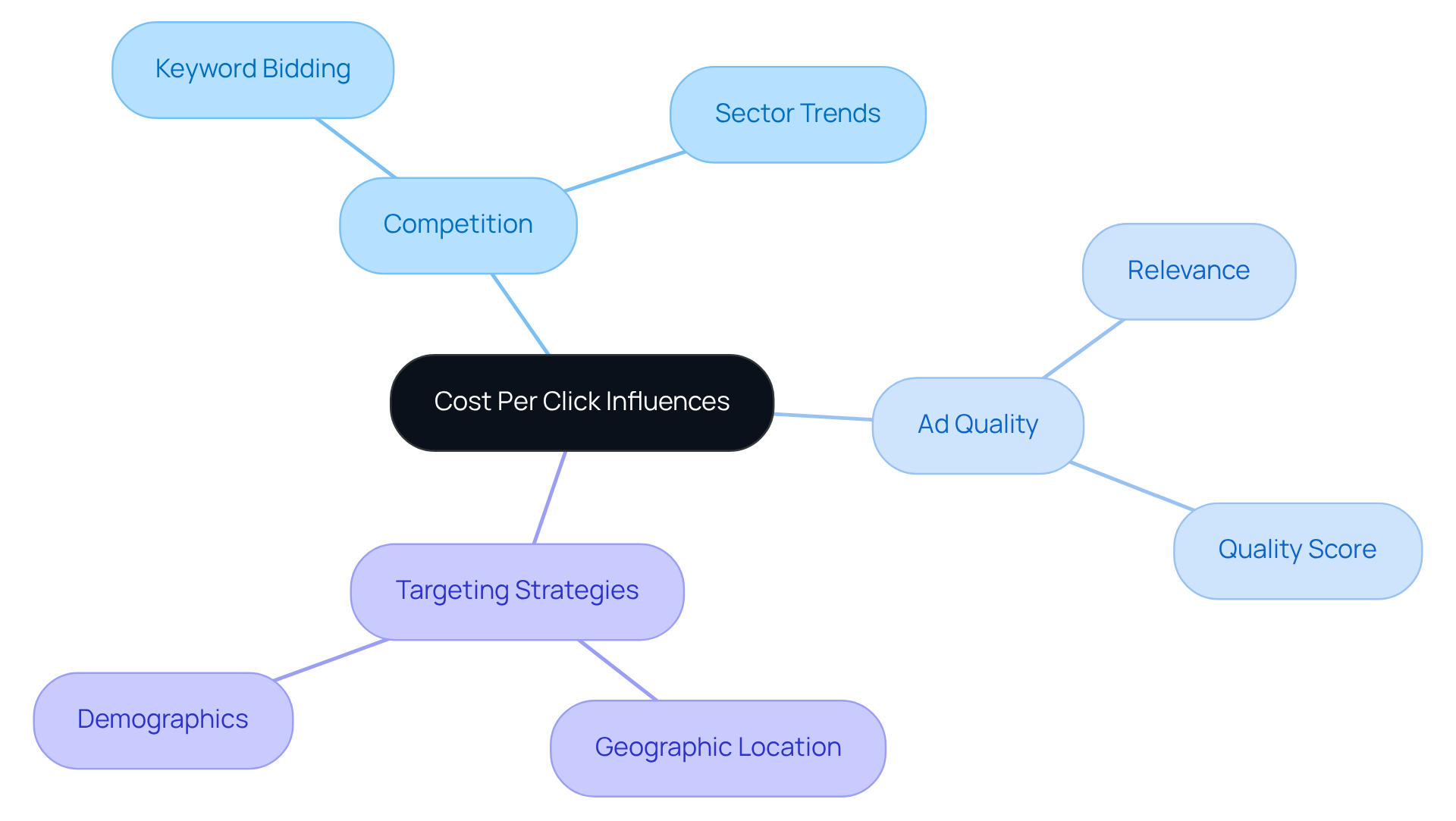Overview
Navigating the world of digital advertising can feel overwhelming, especially when it comes to understanding Cost Per Click (CPC). This concept is not just a number; it represents a significant challenge for many marketers who strive to make every penny count. Without a clear grasp of CPC, you may find yourself struggling to evaluate the effectiveness of your campaigns, manage your budgets wisely, and ultimately optimize your strategies for a better return on investment.
Imagine pouring resources into campaigns, only to realize that your costs are spiraling out of control due to factors like ad quality and targeting. This can lead to frustration and uncertainty, leaving you wondering if your efforts are truly paying off. It's a common pain point that many founders experience, and it can be disheartening.
However, understanding CPC is not just about numbers; it's about empowering yourself to make informed decisions. By taking the time to learn how CPC is calculated and what influences it, you can transform your approach to digital advertising. Consider how improving your ad quality and refining your targeting can significantly lower your costs, allowing you to stretch your budget further.
At RNO1, we believe in supporting you through this journey. We’re here to help you navigate the complexities of CPC, offering insights and strategies tailored to your unique needs. Together, we can create a path that not only alleviates your concerns but also enhances your advertising effectiveness. Remember, you’re not alone in this; we’re in this together, and there’s a community ready to support you every step of the way.
Introduction
Navigating the complexities of Cost Per Click (CPC) can feel overwhelming for many advertisers in the bustling world of digital marketing. This important metric not only highlights the financial aspects of online promotions but also acts as a key indicator of how well a campaign is performing.
As the digital advertising landscape evolves, many marketers find themselves grappling with the challenge of managing their budgets while striving for optimal engagement. It’s understandable to feel uncertain in this competitive environment.
By delving into the meaning, calculation, and various factors that influence CPC, we uncover valuable insights that can empower you as an advertiser. Together, we can enhance your strategies and work towards maximizing your return on investment, ensuring you feel supported every step of the way.
Define Cost Per Click (CPC)
Many advertisers find that understanding CPC meaning can feel overwhelming, especially when navigating the complexities of online promotion. It’s crucial to grasp how much you’re spending for each interaction with your ad, as this metric plays a significant role in pay-per-click (PPC) marketing models. The reality is, you only incur costs when a user engages with your ad, but how do you ensure that engagement is worth the investment?
The [CPC is determined through a competitive auction mechanism](https://blog.rno1.com/what-is-a-creativity-agency-understanding-its-role-and-impact) where advertisers bid on keywords, which means that both competition and ad quality can significantly influence your costs. Imagine spending a substantial amount on a campaign only to find that your CPC is higher than expected. To calculate your CPC, simply divide the total cost of your campaign by the number of interactions it generates. For instance, if you invest $100 in a campaign that results in 50 interactions, your CPC would be $2. This metric is vital for assessing how effectively your advertising efforts are performing across various platforms, including search engines, social media, and display networks.
In 2025, it’s important to note that average CPC rates can vary widely across industries. For example, the finance sector sees an average of about $5.16 per interaction, while education tends to have lower rates around $2.45. This disparity underscores the importance of understanding the CPC meaning and how it relates to the purchases made by clients. If you’re a marketer striving to enhance your campaigns and achieve a positive return on investment, grasping the nuances of CPC is essential.
Moreover, knowing the CPC meaning is crucial; it indicates the maximum cost per click, which is the highest amount you could be charged for a click, factoring in your base bid and any adjustments. Understanding CPC and its is vital for improving your ad placements and overall campaign performance. Remember, you’re not alone in this journey—many have faced similar challenges, and with the right knowledge and support, you can navigate the complexities of CPC to foster successful advertising strategies.

Explain the Importance of CPC in Digital Advertising
The cpc meaning represents a significant challenge in digital marketing that many face. Managing advertising budgets can feel overwhelming, especially when you're unsure if you're truly getting value from your spending. It’s frustrating to think you might be pouring money into campaigns that aren’t performing as well as they could. This is where CPC becomes a beacon of hope. It allows marketers to oversee their budgets efficiently by billing only for genuine interactions, transforming what could be a daunting task into a more manageable one.
As a key performance indicator (KPI), the cpc meaning helps you evaluate the effectiveness of your campaigns. A lower CPC often signifies a more efficient campaign, while a higher CPC may suggest it’s time to optimize your strategy. Understanding is essential for making informed decisions about bidding strategies, keyword selection, and ad placements—all of which can enhance your return on investment (ROI).
In 2025, as digital advertising continues to evolve, mastering the cpc meaning will be crucial for gaining a competitive edge. Companies that have optimized their CPC strategies often share stories of significant improvements in their ROI, highlighting the direct correlation between effective CPC management and overall marketing success.
Experts in the field emphasize that understanding CPC meaning is essential, as a well-calibrated CPC can lead to better budget allocation and improved campaign performance, reinforcing its importance in the digital marketing landscape. Together, we can navigate this journey and ensure that your marketing efforts not only meet but exceed your expectations.

Detail How to Calculate Cost Per Click
Understanding the cpc meaning can often feel daunting when , especially for those who are just starting their journey in advertising. The formula is quite straightforward:
CPC = Total Cost of Campaign / Total Number of Clicks.
For instance, imagine a promoter who invests $500 in a campaign that generates 250 interactions. The CPC would be calculated as follows:
CPC = $500 / 250 = $2.
This indicates that the promoter pays $2 for each click on their ad, which can be a significant expense when budgets are tight. It's vital to recognize that the cpc meaning can fluctuate based on various factors such as competition, ad quality, and targeting strategies, which can add to the stress of managing an effective campaign.
However, there is hope. Advertisers can utilize tools provided by platforms like Google Ads to monitor and adjust their CPC in real-time. This empowers them to stay within budget while maximizing ad performance, ultimately alleviating some of the pressure. By understanding these dynamics, you can navigate your advertising efforts with greater confidence and ease.
.](https://images.tely.ai/telyai/poccvahk-follow-the-flow-from-the-total-cost-and-number-of-clicks-to-see-how-the-cpc-is-calculated-each-step-shows-how-the-values-relate-to-one-another-leading-to-the-final-cost-per-click.webp)
Identify Factors Influencing Cost Per Click
In the world of digital marketing, many face the challenge of rising Cost Per Click (CPC) rates, leading them to seek clarity on CPC meaning, particularly in competitive sectors like finance and insurance. As companies vie for the same keywords, it can feel overwhelming to keep costs manageable. For instance, the average CPC in Google Ads search marketing in the U.S. is $4.66, and a staggering 86% of sectors experienced an increase in CPC between 2023 and 2024. This highlights the fierce competition for visibility in search results, which can be daunting for many businesses.
However, there is hope. Ad quality plays a crucial role in influencing CPC. When advertisements are relevant and engaging, they tend to perform better, leading to . A higher Quality Score, which reflects the ad's relevance to keywords and its past performance, can translate into significant cost savings. As SEO Strategist Albert Badalyan insightfully notes, "Google Ads is one of the most powerful digital advertising platforms, helping businesses reach their target audiences." This emphasizes the importance of crafting ad content that resonates with your audience, ultimately having a positive impact on CPC meaning.
Moreover, targeting strategies are essential in determining CPC. Geographic location and audience demographics significantly influence the costs companies incur for clicks. For example, targeting urban areas with higher purchasing power may lead to increased competition and, consequently, higher CPC. Conversely, focusing on niche markets or long-tail keywords can help marketers reduce expenses while still connecting with the right audiences.
To navigate these challenges and maintain an optimal CPC, it's vital for advertisers to understand the CPC meaning, continuously monitor these factors, and make necessary adjustments to their campaigns. This proactive approach not only aids in managing costs but also enhances overall campaign effectiveness, ensuring that advertising budgets are utilized wisely. Remember, you are not alone in this journey; with the right strategies and support, achieving your marketing objectives is within reach.

Conclusion
Understanding the meaning of Cost Per Click (CPC) is essential for anyone involved in digital advertising, especially when navigating the complexities of this fast-paced environment. Many advertisers struggle with the expenses incurred for each interaction with an ad, often feeling overwhelmed by the pressure to achieve campaign success. This metric not only reflects these expenses but also serves as a crucial indicator of campaign performance, making it vital for marketers to grasp its intricacies. By doing so, they can make informed decisions that directly impact their return on investment and overall advertising effectiveness.
Throughout this article, we’ve shared key insights on how to calculate CPC, the factors influencing it, and its significance in managing advertising budgets. The straightforward calculation of CPC—simply dividing the total cost of a campaign by the number of clicks—provides a clear picture of advertising efficiency. However, it’s important to recognize the impact of competition, ad quality, and targeting strategies on CPC rates, which can add layers of complexity to optimizing campaigns. Many marketers find themselves grappling with these challenges, feeling the weight of their decisions.
Ultimately, mastering CPC is not just about managing costs; it’s about leveraging this knowledge to enhance advertising strategies and achieve better outcomes. As digital marketing continues to evolve, staying informed about CPC dynamics will empower you to navigate challenges effectively and maximize your marketing efforts. Embracing this understanding can lead to more strategic decision-making, fostering a sense of control in the competitive landscape of online advertising. Remember, you are not alone in this journey; together, we can drive success and create a thriving community of informed advertisers.
Frequently Asked Questions
What does Cost Per Click (CPC) mean?
Cost Per Click (CPC) is a metric that indicates how much an advertiser spends for each interaction with their ad. It is a key component of pay-per-click (PPC) marketing models.
How is CPC calculated?
CPC is calculated by dividing the total cost of the campaign by the number of interactions it generates. For example, if you invest $100 in a campaign that results in 50 interactions, your CPC would be $2.
What factors influence CPC?
CPC is influenced by a competitive auction mechanism where advertisers bid on keywords, meaning that both competition and ad quality can significantly affect costs.
How do average CPC rates vary across industries?
Average CPC rates can vary widely across industries. For instance, the finance sector has an average CPC of about $5.16 per interaction, while the education sector tends to have lower rates around $2.45.
Why is understanding CPC important for marketers?
Understanding CPC is crucial for marketers as it helps assess the effectiveness of advertising efforts, enhances campaign performance, and ensures a positive return on investment.
What is the maximum cost per click?
The maximum cost per click is the highest amount you could be charged for a click, which takes into account your base bid and any adjustments.
How does CPC relate to Quality Score?
Understanding CPC and its relationship with Quality Score is vital for improving ad placements and overall campaign performance.




